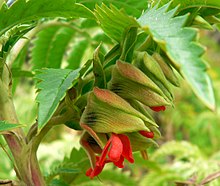|
Melianthus comosus
Melianthus comosus, the honey flower, is a species of flowering plant in the family Francoaceae. It is native to the mostly dry regions of southern Africa. The attractive multi-stemmed shrubs are popular garden subjects. The Afrikaans name kruidjie-roer-my-nie (herb-touch-me-not) alludes to the unpleasant smell that results from bruising of any part of the plant.[3] The vegetative parts are very toxic, as with other Melianthus species, and extracts of the leaves and stem have anti-bacterial properties.[4] RangeIt is native to South Africa, western Lesotho and southern Namibia, where it occurs from 400 to 2,000 m above sea level.[2] In South Africa it occurs in the greater part of the Cape and Free State provinces, and locally in North West, Gauteng and Mpumalanga. FlowersThe flowers which produce copious black nectar[note 1] are zygomorphic in shape, and green to pale pink in colour.[2][5] The black nectar is visible through the pale green, semi-transparent sepals. A flower produces an average of 42 μl of nectar a day, with a 10% sugar content, which has been described as a "rich black honey" that almost fills the cup.[6] Vahl's description of the species in 1794 however omitted any mention of the coloured nectar, or its abundance.[2] Uses and species associationsHoney from its flowers is dark in colour, and apparently not toxic to humans.[7] The flowers are visited by insects and birds,[2] especially sunbirds which eagerly seek them out.[6][8] Notes
ReferencesWikimedia Commons has media related to Melianthus comosus.
|
||||||||||||||||||||||||||||||||
